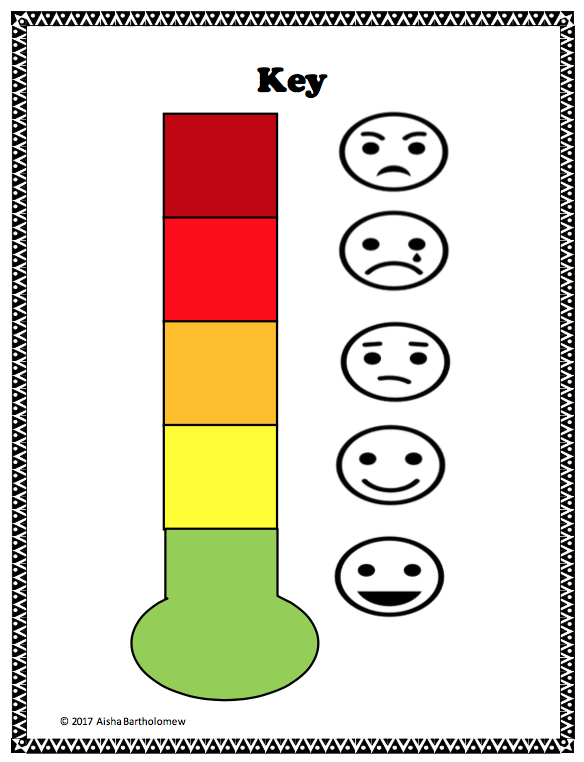Hey everyone!
Today we wanted to talk about managing our emotions, and we found this amazing resource that we wanted to share with you all. It’s called the Feelings Thermometer Plus and we think it could really help us understand and manage how we’re feeling.
Feelings Thermometer
 The Feelings Thermometer may look like a simple tool, but it can really help us visualize and understand our emotions. Here’s how it works:
The Feelings Thermometer may look like a simple tool, but it can really help us visualize and understand our emotions. Here’s how it works:
The thermometer is split into temperature zones, each corresponding to a different level of intensity in our feelings. The blue zone at the bottom represents feelings of calm, relaxed, and happy. The green zone represents feeling a little bit excited, interested or amused. The yellow zone represents feeling annoyed, frustrated, worried or disappointed. The red zone represents feeling angry, mad, overwhelmed, or out of control.
Each of us may experience different emotions in different ways, so the thermometer is a personal tool that can help us understand and visualize our feelings on our own terms. By checking in with ourselves regularly, we can make sense of our emotions and decide the best way to respond to various situations.
Feelings Diary
The Feelings Thermometer is a great place to start, but it’s also important to develop our emotional intelligence further. That’s where the Feelings Diary comes in. A feelings diary is a way of recording our emotions on a regular basis, so that we can identify patterns and triggers that cause certain emotions. Here’s how to start:
First, find a quiet place where you can reflect on your thoughts and feelings without distraction. Choose a notebook or journal that you like and feel comfortable writing in. Decide on a regular time each day to write in your diary, and stick to it as much as possible. This way, the diary becomes a part of your daily routine and you’re more likely to stick with it.
When you sit down to write, start by identifying the emotions you’re feeling. You can use the Feelings Thermometer to help you identify which zone your emotions fall into. Then, try to identify what caused the emotion. What happened or what thought triggered the emotion?
Once you’ve identified the emotion and the cause, try to write about it in more detail. How does the emotion feel physically and emotionally? How long did it last? Did anything help alleviate the emotion?
By keeping a Feelings Diary, we start to see patterns emerge. We may find that certain situations or people always trigger a particular emotion. Knowing this can help us make choices that avoid those triggers, or develop coping strategies for when we can’t avoid them. It can also help us to connect with our emotions in a deeper and more meaningful way, allowing us to be more authentic and empathetic in our interactions with others.
Taking Action
Understanding our emotions is important, but it’s only the first step. We also need to be able to take action in response to our emotions. Here are some ways that we can respond when we’re feeling different emotions:
Calm and happy: Enjoy the feeling and try to make the most of it! Take some time to do something you enjoy, or simply revel in the feeling of calm. If you notice that you’re feeling happy less often than you’d like, try to identify why that might be. Are there things you could do to increase the amount of happiness in your life?
A little bit excited: This is a great feeling of positive energy and anticipation. Use this energy to tackle tasks that require focus and enthusiasm, like a project at work or a new hobby. If you find yourself feeling overly anxious or restless, try to channel that energy into something constructive.
Worried or disappointed: These emotions can be difficult to deal with, but they’re an inevitable part of life. Try to recognize that some things are beyond your control, and focus on the things that you can control. Take some time to prioritize your goals and work towards them, and remind yourself of your accomplishments and successes.
Angry or overwhelmed: When we feel like we’re losing control, it’s important to take a step back and calm down. Try taking some deep breaths, or stepping away from the situation for a few minutes. Once you’ve regained your composure, you can decide on the best way to respond.
Final Thoughts
We hope you’ve found this discussion on managing emotions helpful. Remember, being in touch with our emotions is an important part of being human. With the right tools, we can understand and manage our emotions in a way that allows us to live our best lives.
Thanks for reading and see you next time!